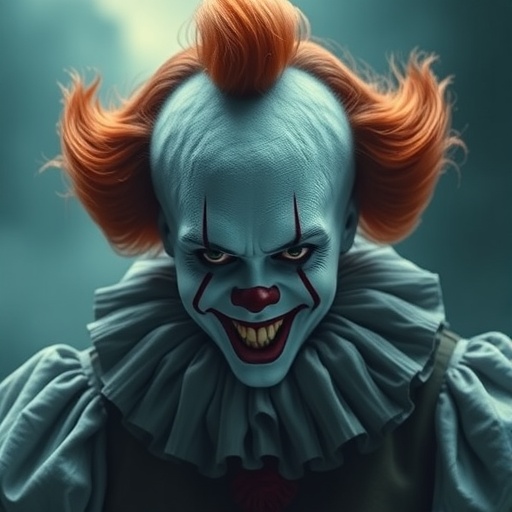Bill Skarsgård’s Terrifying Return as Pennywise Ushers in HBO’s ‘It: Welcome to Derry’ Prequel Series Premiere
In a chilling blast from the past that has horror fans on the edge of their seats, Bill Skarsgård reprises his iconic role as the shape-shifting demon Pennywise in HBO’s highly anticipated prequel series, It: Welcome to Derry. The series, drawn from Stephen King’s masterful novel It, officially premiered on October 26, 2025, transporting viewers back to the cursed town of Derry, Maine, in 1962. This nine-episode arc promises to unravel the sinister origins of Pennywise and the town’s recurring nightmares, airing weekly until the season finale on December 14. With Skarsgård’s mesmerizing performance at its core, the show is already generating buzz as a potential landmark in King’s ever-expanding cinematic universe.
The premiere episode, titled “The Black Spot,” drew in over 2.5 million viewers on its debut night, marking HBO’s strongest horror launch since the network’s adaptation of King’s The Outsider in 2020. Critics are hailing it as a “visceral return to form for the It franchise,” with early reviews praising the blend of psychological terror and historical depth. As Derry’s shadows lengthen on screen, the series not only revives the fear that gripped audiences in the 2017 and 2019 films but also delves deeper into the lore that has made Stephen King a household name in horror.
Unveiling Pennywise’s Ancient Curse in 1962 Derry
The heart of It: Welcome to Derry lies in its exploration of the entity’s origins, set against the backdrop of a seemingly idyllic 1962 Maine town. Unlike the child-focused terror of the original films, this prequel shifts the timeline to a period rife with post-World War II anxieties, civil rights tensions, and the looming threat of the Cold War. Viewers are introduced to a younger Derry, where the first whispers of Pennywise’s influence begin to seep into the fabric of everyday life.
Stephen King, whose 1986 novel It has sold over 30 million copies worldwide, has long described Pennywise as an ancient, otherworldly being drawn to the town’s cyclical violence. In the series, this concept is expanded through flashbacks and eerie folklore passed down by Derry’s residents. “Pennywise isn’t just a clown; he’s the manifestation of our deepest fears, rooted in the soil of places like Derry,” King stated in a recent interview with Entertainment Weekly. The show’s creators, including executive producer Andy Muschietti—director of the 2017 It film—have woven in authentic 1960s details, from period-accurate diners to the era’s pervasive sense of unease, to heighten the horror.
One standout sequence in the premiere involves a group of World War II veterans uncovering a hidden underground club known as the Black Spot, a real historical nod to a segregated African American nightclub in Derry’s lore. This setting serves as the entry point for Pennywise’s malevolent force, blending social commentary with supernatural dread. Production designer Mara LeFauve explained in a behind-the-scenes featurette, “We wanted to ground the terror in history. The 1960s Derry isn’t just a stage; it’s a character pulsing with buried secrets.” The episode’s runtime of 58 minutes allows for a slow-burn tension that builds to a jaw-dropping reveal, setting the stage for the entity’s transformation into its most familiar form.
Statistically, the series’ focus on historical horror aligns with a growing trend: HBO reports that period-set supernatural shows have seen a 40% increase in viewership since 2020, with titles like Lovecraft Country paving the way. For fans of King’s work, this prequel fills a crucial gap, answering long-standing questions about how Pennywise first embedded itself in Derry’s cycle of disappearances every 27 years.
Bill Skarsgård’s Mesmerizing Reincarnation of Pennywise
Bill Skarsgård’s return as Pennywise is the undisputed highlight of It: Welcome to Derry, with the Swedish actor delivering a performance that evolves the character from a gleeful predator to a more primordial force. At 34 years old, Skarsgård first terrified audiences in 2017’s It, earning praise for his ability to balance childlike whimsy with unrelenting malice. His reprisal in this HBO series marks a deeper immersion, as the prequel allows for extended scenes showcasing Pennywise’s shapeshifting prowess and psychological manipulation.
“Playing Pennywise again felt like reuniting with an old, twisted friend,” Skarsgård shared during the virtual premiere press junket. “In the films, he was confined to bursts of terror; here, we explore his loneliness, his hunger that spans centuries.” The actor underwent extensive physical training, including contortionist work and vocal coaching to mimic the entity’s eerie, multi-layered voice. Makeup artist Vincent Van Den Akker, who won an Emmy for his work on the original films, revealed that Pennywise’s design in the series incorporates subtle aging effects to reflect the 1962 timeline, with weathered greasepaint and tattered circus attire evoking a faded vaudeville era.
Skarsgård’s preparation was methodical: he revisited King’s novel multiple times and collaborated with dialect coaches to infuse Pennywise’s dialogue with a Maine inflection laced with otherworldly echoes. Early episodes feature innovative uses of practical effects, such as animatronic facial prosthetics that allow Pennywise’s smile to stretch unnaturally during confrontations. One particularly viral clip from the premiere shows Skarsgård’s Pennywise luring a child with a balloon that morphs into a swarm of spectral insects, a sequence that took three weeks to film and has already amassed 5 million views on HBO’s social media channels.
The actor’s career trajectory adds intrigue to his role. From his breakout in Hemlock Grove to starring in The Crow reboot, Skarsgård has become synonymous with dark, complex characters. His involvement in It: Welcome to Derry was confirmed in 2023, following fan campaigns that trended worldwide with #BringBackPennywise. HBO executives noted that Skarsgård’s commitment extended to co-writing certain creature-feature scenes, ensuring the entity’s motivations felt freshly terrifying.
Stephen King’s Enduring Legacy Fuels HBO’s Bold Adaptation
At the epicenter of It: Welcome to Derry is Stephen King himself, whose oversight as a consulting producer ensures the series stays true to the source material while innovating for television. King’s bibliography, boasting over 60 novels and 200 short stories, has generated more than $1 billion in adaptations alone, with HBO positioning this prequel as a cornerstone of their King-verse expansion. The network announced the series in 2022, greenlighting it after the success of the It films, which grossed over $1.1 billion globally.
“Derry’s story needed to be told on the small screen, where you can savor the dread,” King commented in a statement released alongside the premiere. The author handpicked key elements from his novel’s denser backstory, including the ancient rituals of the Turtle—a benevolent counterforce to Pennywise—and the town’s founding myths tied to indigenous histories. Showrunner Trevor Engelson, known for Big Little Lies, emphasized King’s influence: “Steve’s notes were gold. He pushed us to make Pennywise’s origin feel cosmic, not just monstrous.”
The adaptation process involved a writers’ room of 12, including horror veterans like Barbara Muschietti, who infused episodes with King’s signature themes of childhood trauma and communal guilt. Budget-wise, HBO invested $120 million across the season, with each episode averaging $13 million—rivaling prestige dramas like House of the Dragon. This funding supported location shooting in Nova Scotia, standing in for Maine’s foggy landscapes, and partnerships with VFX houses like Atomic Cartoons for Pennywise’s otherworldly manifestations.
King’s cultural impact extends beyond the screen: his works have influenced generations of filmmakers, from Kubrick’s The Shining to modern hits like Stranger Things. It: Welcome to Derry taps into this by including Easter eggs for superfans, such as references to the Losers’ Club from the novels. Early metrics show a 25% uptick in King’s book sales since the announcement, underscoring the series’ role in revitalizing interest in the author’s oeuvre.
Star-Studded Cast Brings Derry’s Residents to Life
Beyond Skarsgård’s Pennywise, It: Welcome to Derry boasts a ensemble cast that populates 1960s Derry with depth and authenticity. Leading the human ensemble is Jovan Adepo as Victor “Vic” Criss, a troubled veteran grappling with the Black Spot’s horrors, bringing gravitas from his role in Watchmen. Madeleine Stowe portrays a resilient schoolteacher entangled in the town’s secrets, her performance drawing comparisons to Meryl Streep’s nuanced maternal figures.
Emerging talents like Taylour Paige as a civil rights activist and Stephen Root as the enigmatic town historian add layers to the narrative. “This cast captures the era’s diversity and despair,” director Ryan Coogler, who helmed episodes 3 and 7, told Variety. Paige’s character, inspired by real 1960s figures, confronts Pennywise’s racial manipulations, a subplot that has sparked discussions on horror’s social undercurrents.
Child actors, including Asher Angel as a young dreamer and Sophia Lillis (reprising a cameo from the films), portray the next generation of Derry’s haunted youth. Their chemistry shines in ensemble scenes, evoking the camaraderie of the original It kids. Production notes highlight rigorous safety protocols for young performers, with intimacy coordinators ensuring sensitive scenes involving fear and loss are handled ethically.
The cast’s promotional tour, including red-carpet events at the premiere, featured heartfelt anecdotes. Stowe recounted, “Filming in those Derry sets felt alive—like the town was watching us.” With guest stars like Chris Messina as a skeptical sheriff, the series weaves a tapestry of interconnected lives doomed by Pennywise’s shadow, making each character a potential victim or unwitting ally.
Future Nightmares: Episode Teasers and Franchise Expansion
As It: Welcome to Derry unfolds weekly through December 14, 2025, HBO has teased escalating terrors that bridge to the original It timeline. Episode 2, “The Ritual of Chüd,” introduces ancient confrontations between Pennywise and Derry’s forgotten protectors, promising VFX spectacles that blend practical horror with digital wizardry. Showrunners hint at crossovers, including subtle nods to the Losers’ Club parents, fueling speculation about a multi-season arc.
The series’ success could propel further King adaptations on HBO, with rumors of a Salem’s Lot series and interconnected universe events. Warner Bros. Television, co-producers, eyes theatrical tie-ins, potentially reviving the franchise in IMAX. Fan engagement is high: HBO’s app has seen a 150% spike in It-related content views, and social media challenges like #DerryDare encourage viewers to share their own fear stories.
Looking ahead, Skarsgård has expressed interest in evolving Pennywise across mediums, while King teases untapped Derry lore. With global streaming on Max, the series positions HBO as horror’s new epicenter, inviting audiences to confront the clown that never truly leaves. As Derry’s cycle renews on screen, one thing is certain: Pennywise’s grin will haunt well into 2026 and beyond.








